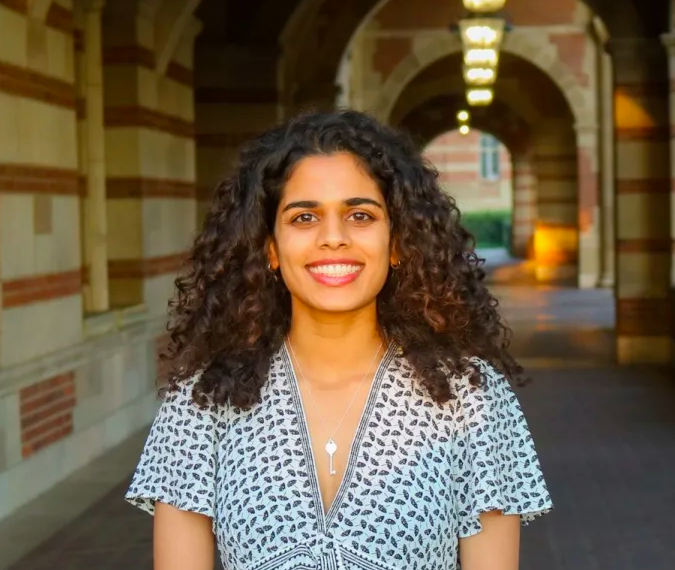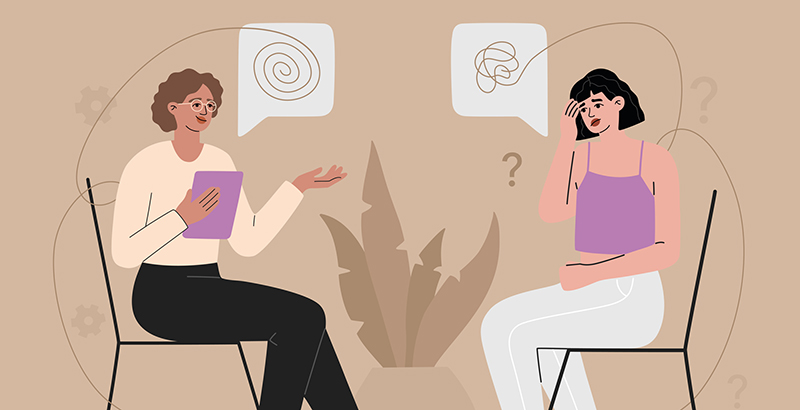Get stories like this delivered straight to your inbox. Sign up for The 74 Newsletter
When the campus alert system at the University of California at Los Angeles notified students of a possible shooter this February and directed them to shelter in place, senior Meera Varma found herself surrounded by frightened students. She told the alarmed undergrads hunkered down in the dorm it was okay to be scared – a technique she’d learned in a mental health training.
“Residents told me they were really nervous, they didn’t know what to do,” said Varma, a resident advisor at the dorm. “I validated their feelings and told them you’re not alone in feeling scared. I told them I appreciated that they trusted me and wanted to come to me.” She then assured them that she could refer them to the counseling center once the danger was over.
The tool that Varma used, which goes by the acronym VAR – validate, appreciate, refer – was created by a national mental health organization for students called Active Minds. The group teaches thousands of students the crisis intervention technique each year in 600 campus chapters.

Varma, who spent two years as the UCLA Active Minds education committee director, first heard about the group when she was so deep in mental distress that she wasn’t sure she was going to get out. “I didn’t see a point to living,” she recalled.
A native of Burbank, California, Varma became extremely depressed in high school and began self-harming, then formed a plan to die by suicide just before her 18th birthday – a plan she never went through with. “I almost didn’t make it to 18, but I’m grateful that I’m here right now,” said Varma, who will turn 22 in April.
Varma is one of a growing group of college students who are struggling with their mental health. Recent headlines about college suicides, from star soccer player Katie Meyer at Stanford to clusters at St. Louis University, West Virginia University, Vanderbilt University and others, have stunned the country. Suicide is now the second most common cause of death on college campuses, and more than 1,000 college students kill themselves each year – triple the rate from the 1950s.
The mental health crisis on campus was growing long before Covid-19. Data from the Youth Risk Behavior Survey compiled by the Centers for Disease Control and Prevention show that levels of persistent sadness and hopelessness, as well as suicidal thinking, planning and attempts among adolescents rose steadily from 2009 to 2019. Then came online classes and school closures, campus lockdowns, and the disruption of normal college social life, exacerbating the problem.
The 2021 Healthy Minds Study report, an online survey of more than 103,000 college students, found that over the previous year, 41% reported clinical levels of depression, 34% showed symptoms of anxiety, 13% considered suicide, and 1% attempted suicide. But this spike in despair was not just a product of the pandemic, said Sarah Lipson, one of the report’s principal investigators.
“Really high levels of depression and anxiety” were present before the pandemic, and had climbed 2% to 3% every semester since 2015, said Lipson, an assistant professor of health law policy and management at Boston University School of Public Health.
The U.S. Surgeon General’s advisory on the youth mental health crisis, issued in December, reported that pre-pandemic, “an alarming number of young people struggled with feelings of helplessness, depression and thoughts of suicide.” With the stress of COVID-19, the report said, “the effect on their mental health has been devastating.”
College administrators have scrambled to expand mental health services, with some adopting a “web of care” approach that tries to prevent students from reaching a crisis point. Many are developing innovations that reach beyond the counseling center, including telehealth therapy, mental health check-in apps, advisor and faculty training on suicide prevention, and peer support groups – as well as simple but important changes, such as printing the Suicide Prevention Lifeline phone number on the back of student ID cards.
On the ground, however, students say their experience with mental health support is mixed. Caroline Knowles, a senior at Vassar, got a quick appointment at the school’s counseling center when she needed to see a therapist for persistent anxiety. But a friend who requested a safety check on a student believed to be self-harming got a meager response. “The school sent someone to knock on her door, and a complete stranger asked, ‘Are you OK?’” Knowles said. “Of course, the girl said, ‘Yes I’m fine, leave me alone,’ and that was that. It’s a flawed system.”
In addition, some campus counseling centers close down over the holidays, stranding students without a trusted place to call for help.
Enlisting faculty and staff to prevent suicide
Melody Moezzi is an Iranian-American writer, professor and mental health activist with three books under her belt, including Haldol and Hyacinths: A Bipolar Life, and The Rumi Prescription. But in graduate school, she had a severe encounter with mental illness that almost stilled her voice forever.

In Moezzi’s last semester of graduate school at Emory University, she was severely stressed. She’d been diagnosed with major depressive disorder – a diagnosis that turned out to be wrong – and was given antidepressants as she worked to complete degrees in law and public health. Then an administrator suggested she might not graduate according to her desired timeline, and she decided, as she put it, “to check out.” Fortunately, she survived.
“Looking back on it, I think, what a stupid reason to kill yourself,” she told MindSite News. “I have a wonderful husband, I have a wonderful life. Things were not objectively going wrong.”
Now an author, attorney and visiting professor of creative writing at University of North Carolina Wilmington, Moezzi tells her students to ask for help if they are in crisis, something she was too proud to do. She also advocates giving faculty and staff better tools to recognize a student in distress.
In an op-ed for Inside Higher Ed, Moezzi wrote that evidence-based suicide prevention training like QPR – question, persuade, refer – should be mandatory for university staff.
The technique is meant to help a professor or staff member recognize the signs of a student in crisis and ask critical questions at a moment when it may be lifesaving. She uses the technique frequently, and has offered to take students to the emergency room or the university counseling center. She ended up driving one student to the emergency room after they answered “yes” to the question, “Are you thinking of hurting yourself?”
Yet suicide prevention programs like QPR are not mandatory at Moezzi’s university – nor at many others. Active shooter drills are mandatory – a fact she finds ironic, since mass shootings account for 1% of gun casualties and suicides for 60%. In Inside Higher Ed, Moezzi concludes: “Failing to mandate suicide prevention training at colleges and universities in spite of these statistics isn’t just misguided or negligent. It’s ignorant and reckless.”
Nine hundred miles from Moezzi’s school, a team of psychologists at Loyola University in Chicago are piloting another approach. The goal: to reach students before they get to a crisis point by enlisting academic advisors to connect with students about their state of mind.
Colleen Conley and her team at Loyola designed a short “motivational interviewing” curriculum that advisors can use during a routine meeting. Advisors help students reflect on their goals and ask if they might benefit from any changes: Are they getting enough sleep or drinking too much? Is it affecting their mental health? How might the student make a change?
Early results show a promising trend, Conley said. Students interviewed in this way are more likely to seek counseling services, and motivational interviewing is linked to behavior change. Plus, she said, it gets students to discuss mental health at an appointment they’re already attending.
“We found that if we could work even five to ten minutes of talking about well-being into a meeting that was already happening, that was so much easier than relying on students to schedule a separate appointment,” Conley said.
In Winston-Salem North Carolina, Wake Forest University uses an app called Timely Care to provide 24/7 access to a mental health professional for students in crisis. The app also makes it easy for students to schedule non-urgent counseling appointments and provides coaching on diet, nutrition, exercise and sleep.
As colleges work to support student mental health, there’s still a lack of evidence on what works best, said Boston University’s Lipson, partly because each campus is different.
“While a public health approach is the starting point for addressing mental health at colleges and universities, there isn’t a one-size-fits-all approach,” she said. “What works for one campus may not work for another.”
One approach that seems both popular and effective, however, is peer support.
When peers are the ‘first line of defense’
When a friend told Kelly Maguire, a senior at Florida Gulf Coast University in Fort Myers, about a crisis they were experiencing, she knew how to respond: “Thanks for telling me about this,” Maguire said. “Could I walk with you to the counseling center right now?”
Maguire, now president of the campus chapter of Active Minds, went through her own mental health crisis during freshman year. Anxiety, depression, and suicidal ideation became unmanageable. Now Maguire wants to make it normal for friends to talk about struggles.
Peer recognition is often the first line of defense, said Amy Gatto, senior manager of higher education and evaluation at Active Minds. Research has shown that peers may be “the single most potent source of influence” during college.
Active Minds was founded by Alison Malmon, whose brother had kept his deepening depression and psychosis a secret for years and committed suicide during his senior year of college.
Now Active Minds reaches students through mental health fairs and student liaisons, spreading the message that talking to friends when you’re struggling is no sign of weakness. The group’s “Send Silence Packing” campus events events include more than 1,000 backpacks – one for each of the roughly 1,000 campus suicides that occur each year. The backpacks include personal stories from families and friends of suicide victims and encourage students to reach out if they need help.
When a suicide does occur, more schools are adopting research-backed postvention strategies, with the aim of preventing further suicides in a new, high-risk group: suicide loss survivors. When two suicides rocked the University of North Carolina-Chapel Hill campus last year, senior Ethan Phillips – who knew of more than a dozen kids’ suicides in his county while he was in middle school – helped spread the word about counseling resources for students.
For many college students, parents are often the last to know if they are suffering from mental health issues or failing academically. Gina Burton only found out after her son, Graham, committed suicide in 2018 that he had been in great distress and failing four classes at Hamilton College, according to a story in the New York Times.
“Would you care to shed some light on this?” Ms. Burton asked in an angry email to the academic dean, according to the Times. “If this is what drove Graham, I don’t think I’ll be able to cope.”
Many parents don’t know they can be left out of a student’s mental health treatment entirely due to due to health and education privacy laws – HIPAA and the Family Education Right and Privacy Act – that afford privacy to adult students, said B. Janet Hibbs, an adolescent clinical psychologist in Philadelphia. Hibbs recommends that parents and students sign these crucial forms before students head to school so families can have access to health information.
In her experience, few college counselors include the family in students’ therapy, Hibbs said – a major missed opportunity. “The familial context can be a tremendous resource,” she said.
In fact, when Hibbs’ own son had a severe depression during his freshman year that ultimately led him to take a medical leave of absence, the counseling office and faculty were unable to communicate with each other because of privacy protections.
Many students are unaware of available mental health resources, according to university counselors contacted by MindSite News.
“The challenge with a larger campus is just letting students know what’s available to them,” said Aesha Uqdah, a clinical psychologist and director of the Counseling Center at the University of Louisville. “The word has to spread a lot farther to reach 23,000 people – there are students who probably don’t know where the counseling center is. Students can walk in and talk to someone that day if they’re in a crisis. But people hear we have a waitlist – which we don’t for urgent care – so they don’t even try.”
As more struggling students seek care, universities are scrambling to add resources – but money and staff alone will not solve the crisis, said Marcus Hotaling, president of the Association for University and College Counseling Center Directors.
“This is not a problem we can hire our way out of,” Hotaling said. “For many students, we need to solve a problem. The goal of therapy is not to need therapy, but to develop the coping skills and the life skills to address anxiety and depression. We need to be leaning into solutions.”
Expanding suicide prevention education
Meera Varma, the UCLA senior who helped calm the nerves of her dorm’s rattled undergraduates, is spreading the word about mental health on campus.
When Varma was first diagnosed with anxiety and depression, her immigrant family had a difficult time understanding her diagnosis and treatment. “There isn’t even a word in Hindi for ‘stigma,’” she said. Now she’s got her whole family, even her grandparents, using the VAR technique and talking openly about their mental health.
Risks are not the same across demographic groups. The suicide rate for Black children younger than 13, according to the CDC, is almost twice that of white children. Other groups, like the LGBTQ community, also suffer higher rates of suicide risk.
Lily Brown, director of the Center for the Treatment and Study of Anxiety in the Perelman School of Medicine at the University of Pennsylvania, is part of a new research group aimed at studying those disparities and developing more targeted interventions. While Penn’s INSPIRE Center will look at all age groups, Brown and her colleague José Bauermeister will focus on college students in particular.
They’re working on a low-cost intervention for college students that is brief and technology-based – a life-skills app for students who are a sexual or gender minority.
“People who identify as LGBTQ tend to report that, when they’re struggling with isolation, they get really depressed,” Brown said. “Finding ways to cope with discrimination, finding ways to build a social network, and finding ways of building positive emotions are the core targets of this project.”
Meanwhile, Varma, who is graduating in May, will stay on at UCLA to get a master’s degree in social welfare and mental health policy. Her involvement with Active Minds, the JED Foundation and the American Foundation for Suicide Prevention, has her looking toward a career in mental health.
“I feel like people are intimidated to start conversations about suicide,” she said. “As a person who has been suicidal, and who almost lost their life to suicide, I know what it’s like to be nervous to talk about it. I want to work to create policy changes around suicide prevention. Because it is something that’s preventable.”
This originally appeared at MindSite News and is published here in partnership with the Solutions Journalism Exchange.
Get stories like these delivered straight to your inbox. Sign up for The 74 Newsletter


;)